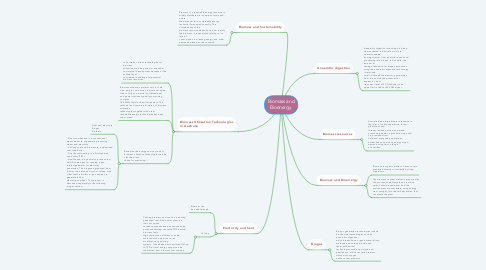Biomass and Bioenergy.
by Daniel Alberto Lopez

1. Biomass Utilisation Technologies in Australia
1.1. In Australia, various technologies for biomass utilisation are being used or are under commercial development because of the availability of considerable existing and potential biomass resources
1.2. Biomass utilisation projects vary in scale from simple combustion in domestic open fires to fully commercial combined heat and power stations typically comprising complex 100 MWe thermo-chemical reactors. The technical and commercial status of biomass utilisation technologies together with other renewable energy technologies has been summarised
1.3. Based on the energy service product, biomass utilisation technologies can be classified into those for producing:
1.3.1. Heat and electricity Biogas Biofuels.
1.3.2. - Direct combustion in a conventional steam boiler to cogenerate processing steam and electricity - Cofiring coal and biomass in a pulverised coal-fired boiler - Directly combusting in a fluidised bed combustor (FBC) - Gasification in a gasifier to produce low calorific value gas for running a gas turbine/generator for electricity generation. The biogases produced from biomass can also be burnt or cofired with other fuels in boilers or gas engines to generate further electricity and heat. That process is described separately in the following biogas section.
2. Electricity and heat
2.1. Biomass can be used through:
2.2. Cofiring
2.2.1. Cofiring biomass and coal in an existing pulverised coal-fired power plant is a low-cost option to reduce greenhouse gas emissions by partly substituting coal with CO2-neutral biomass fuels. High combustion efficiency can be achieved with only minor or no modification to existing systems. It has been demonstrated that up to 15% of total energy output can be substituted from biomass fuel sources.
3. Biomass and Sustainability
3.1. Biomass is a renewable energy resource, is widely distributed in its various forms and offers the potential for a sustainable energy resource if managed correctly. The sustainability of the biomass resource depends on how rapidly the biomass is regenerated relative to its rate of consumption in meeting energy and other demands placed on the resource.
4. Biomass resources
4.1. Australia has a large biomass resource in the form of native vegetation, forest plantations and forestry residues, wood and wood processing wastes, agriculture crops and crop residues from field and processing operations, herbaceous and woody energy crops, wastes arising from a range of activities
5. Biomass and Bioenergy
5.1. Biomass is organic matter of recent origin produced directly or indirectly by living organisms.
5.2. The biomass in plant matter is produced by the process of photosynthesis in which carbon dioxide and water from the environment are converted, using energy from sunlight, into the carbohydrates that constitute the plant.
6. Biogas
6.1. Biogas generation technologies include biochemical technologies such as anaerobic digestion, which breaks down organic material into methane and carbon dioxide and thermal/chemical technologies such as pyrolysis and gasification, which converts biomass wastes into syngas and/or other products.
7. Anaerobic digestion
7.1. Anaerobic digestion technology is being demonstrated in Australia mainly to convert sewage and wet wastes from agriculture and food processing into biogas. In Australia, the amount of sewage feedstock for biogas production using the anaerobic digestion technology is relatively small, although the electricity production from this source has potential for expansion from its current level of 20 GWh/year to an upper limit of about 200 GWh/year.

